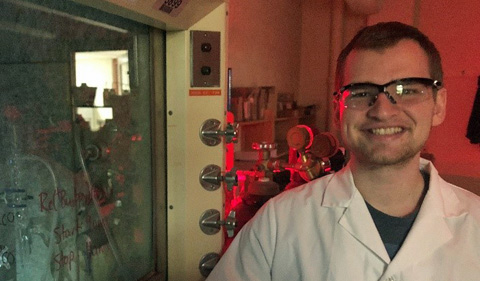Chemistry graduate student Bradley J. McCullough and Dr. Travis A. White recently published the group’s first publication, “Visible light-driven photosystems using heteroleptic Cu(I) photosensitizers and Rh(III) catalysts to produce H2” in Inorganic Chemistry.
McCullough is a graduate student in the Ohio University-Leipzig University dual master’s program, and White is Assistant Professor of Chemistry & Biochemistry at Ohio University.
The publication describes how fine-tuning the structural components of light absorbers and catalysts at the molecular level allows for the development of visible light-driven catalysis to transform water into hydrogen gas. The copper compounds serve to harness incident photons (i.e. solar energy), generating an “excited” molecule with its own unique chemical and physical properties. This excited molecule is able to shuttle electrons from an electron donor source to a rhodium catalyst, the latter of which ultimately delivers the electrons to water to form hydrogen gas. The molecular nature of each component allows for synthetic modification of the structure with relative ease, thereby directly affecting this light-initiated cascade of electrons and energy.
Two Ohio University undergraduate students also contributed to the publication: Bertrand J. Neyhouse ’18 (chemical engineering) who is also a member of White’s group, and Demi T. Reed ’20 (forensic chemistry) who is a member of Dr. Jessica K. White’s group. The other authors on the publication include Professor Christopher J. Ziegler and two of his graduate students in the Chemistry Department at the University of Akron.
Abstract: The synthesis of two new heteroleptic Cu(I) photosensitizers (PS), [Cu(Xantphos)(NN)]PF6 (NN = biq = 2,2′-biquinoline, dmebiq = 2,2′-biquinoline-4,4′-dimethyl ester; Xantphos = 4,5-bis(diphenylphosphino)-9,9-dimethylxanthene), along with the associated structural, photophysical, and electrochemical properties, are described. The biquinoline diimine ligand extends the PS light absorbing properties into the visible with a maximum absorption at 455 and 505 nm for NN = biq and dmebiq, respectively, in CH2Cl2 solvent. Following photoexcitation, both Cu(I) PS are emissive at low energy, albeit displaying stark differences in their excited state lifetimes (τMLCT = 410 ± 5 (biq) and 44 ± 4 ns (dmebiq)). Cyclic voltammetry indicates a Cu-based HOMO and NN-based LUMO for both complexes, whereby the methyl ester substituents stabilize the LUMO within [Cu(Xantphos)(dmebiq)]+ by ∼0.37 V compared to the unsubstituted analogue. When combined with H2O, N,N-dimethylaniline (DMA) electron donor, and cis-[Rh(NN)2Cl2]PF6(NN = Me2bpy = 4,4′-dimethyl-2,2′-bipyridine, bpy = 2,2′-bipyridine, dmebpy = 2,2′-bipyridine-4,4′-dimethyl ester) water reduction catalysts (WRC), photocatalytic H2 evolution is only observed using the [Cu(Xantphos)(biq)]+ PS. Furthermore, the choice of cis-[Rh(NN)2Cl2]+ WRC strongly affects the catalytic activity with turnover numbers (TONRh = mol H2 per mol Rh catalyst) of 25 ± 3, 22 ± 1, and 43 ± 3 for NN = Me2bpy, bpy, and dmebpy, respectively. This work illustrates how ligand modification to carefully tune the PS light absorbing, excited state, and redox-active properties, along with the WRC redox potentials, can have a profound impact on the photoinduced intermolecular electron transfer between components and the subsequent catalytic activity.





















Comments